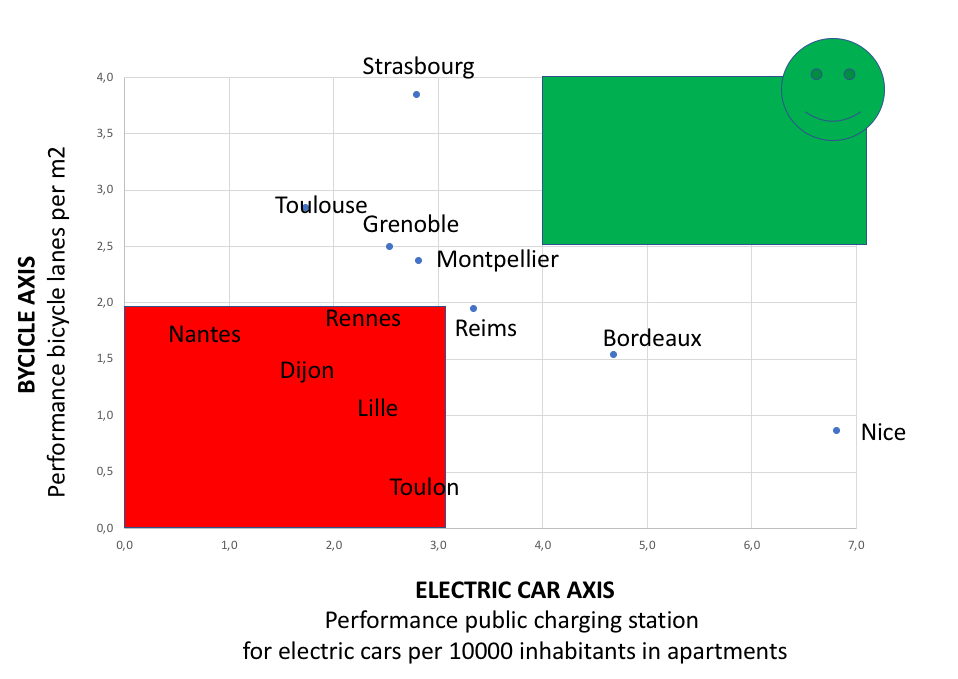
Published in La Caisse des dépôts, on February 10th, 2022, written by Christophe de Charentenay
Choosing a car with a view to limiting its carbon impact has become an exercise for mathematicians! Electric car or rechargeable hybrid, urban or long-distance use profile, recharging in France or elsewhere in Europe, all these parameters have a strong impact on the carbon footprint of the different options.
If we stick to the carbon footprint and for use in France, the ideal solution is to have a 100% electric car equipped with a battery manufactured in France or Sweden (countries with low carbon electricity - under 100g of C02 per Kwh).
As a comparison, a driver driving in Germany with an electric car equipped with a battery manufactured in Germany would emit at least 7 times more CO2 than a driver driving in France with a battery manufactured in France (comparison made for 100,000 km driven)[1]. Indeed, manufacturing a battery requires a lot of electricity (between 120 and 160 Kwh per Kwh of capacity), hence the importance of producing these batteries with decarbonized electricity.
But it is possible to improve the carbon footprint by choosing medium capacity batteries (200 to 250 km of autonomy). The 2019 mobility surveys show us that the French make an average of three return trips per year by car more than 200 km from their home[2]. With an autonomy of 200 Kms, they can make all the other trips without stopping, covering the needs of 98% of the days of the year.
To save one or two hours of recharging time for six trips per year, do they have to double the size of their battery and pay for it between 3000 and 5000 euros of additional cost?
Speaking of battery size, let's look at what happened very recently in the world's leading electric car market, China : in October 2021, almost 40,000 small electric cars of the Wuling brand were sold, putting this model well ahead of all its electric competitors and even in second place among all car models sold in China, all categories combined (thermal, electric, hybrid, etc.).
While the low autonomy is the argument against electric cars, it is precisely the model with the lowest autonomy (about 100 kms) that wins the support of customers. Young Chinese women, living in the poorer inland provinces, form the bulk of the clientele. They pay 3,700 euros for access to carbon-free automotive mobility.
Another original feature of this model is that, unlike its competitors, it has not received any direct subsidy for the purchase. The tens of thousands of monthly sales of this model cost nothing to the public finances of the Chinese state or regions.
The considerable success of this model invalidates the two "conditions" usually claimed for the development of electric cars: increased autonomy and public subsidies.
Let's go back to the European case. Europe has undertaken to get out of China's dependence on batteries by launching a major program to build Giga factories for electric car batteries. The ambition is to reach a capacity of 500 Gwh/year by 2025. Germany is taking the lion's share of the responsibility for setting up these capacities[3].
This program will have two consequences:
- It will feed excess storage capacity distributed in electric vehicles since we see that they will be used only six days a year on average (three round trips). At least 150 Gwh/year of capacity out of the 500 Gwh/year will only be used to provide quasi-permanent overcapacities distributed in the hundreds of thousands of electric cars.
- The battery production capacities installed in areas with carbon electricity will weakly reduce the carbon impact compared to diesel. The additional carbon emission will be 12 million tons per year: 4 tons per battery produced in this 150 Gwh/year capacity.
If carbon impact is a priority for the French and European public authorities, they have the means to act to put Europe back on track for a "carbon friendly" electric vehicle. Four measures are necessary:
- Make subsidies for the purchase of electric cars and the CAFE impact conditional[4] on the decarbonized origin of their battery : an AFC (Appellation Faible Carbone Contrôlée) certificate, similar to the AOC, would be introduced.
- Reserve subsidies for the purchase of vehicles with a battery of less than 30 kWh, i.e. 250 km of autonomy, sufficient for 98% of the days of the year.
- Reserve European investment subsidies to Giga Factory batteries built in low carbon electricity countries..
- Relaunch the rail transport of cars on a few long-distance routes to manage the three average annual long-distance trips and promote range extenders.
For the same service and without changing its lifestyles, Europe could thus save about 10 billion euros in investment (about 150 Gwh/year) and gain 12 million tons of CO2 per year.
Having placed France in the European context, let's take a closer look at the position of major French cities : are they ready for decarbonized mobility?
The acceleration of the transition to low-carbon mobility is based primarily on the development of electric cars and electric bicycles. The use of public transport, which has been around for more than a century, will not suddenly increase except as a result of the multimodal effect.
If we position the main French cities according to the level of equipment in public recharging stations for electric cars and in safe bicycle paths, we see considerable differences of 1 to 8 for recharging stations between Nice, the French champion of recharging stations and Nantes, and of 1 to 7 between Strasbourg, the French champion of bicycle paths and Toulon.
Decarbonated mobility: Are French cities equipped? - Source M@Air

The race has only just begun because the share of electric vehicles in the French fleet is less than 5% and the modal share of bicycles is far from the best in Europe, but some cities are already behind. How to catch up without over-investing?
One thing is certain: the distribution of energy in the form of electricity has nothing to do with the distribution of energy in the form of fuel. Investment strategies that forget this lead to charging station utilization rates of around 5% (see ADEME report, August 2021) for equipment that is up to ten times more expensive than necessary. Do we really need to charge our batteries everywhere in 45 minutes while our cars remain stationary every evening between 10 pm and 7 am?
Finally, the territories that are lagging behind have the opportunity to learn from the first experiences and to provide citizens with low-cost infrastructures that will allow them to fully benefit from the advantage of electric energy in the form of bicycles or cars. The key words of these winning strategies are low power, wide distribution and ease of use.
From the production of batteries to the distribution of energy for decarbonized mobility, France and its territories have a formidable card to play in the decarbonized transition.
Note: Part of this article was published on November 25, 2021 by Les Echos: Opinion | Automobile : quelles batteries électriques pour l’Europe ? | Les Echos
[1] CO2 per Kwh - source European agency - https://www.eea.europa.eu/ -2016
[2] www.statistiques.developpement-durable.gouv.fr/comment-les-francais-se-deplacent-ils-en-2019-resultats-de-lenquete-mobilite-des-personnes.)
[3] Les Echos – Electric mobility : where are the future battery factories - July 14, 2021
[4] CAFE: Corporate Average Fuel Economy - an incentive mechanism to reduce emissions that regulates car manufacturers